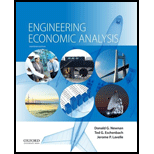
(a)
The
Answer to Problem 64P
The rate of return before income taxes is
Explanation of Solution
Given:
Combined tax rate is
Initial cost is
Annual receipt is
Annual disbursements is
Duration is
Calculation:
Write the expression to calculate the
Here, the depreciation cost is
Substitute
Make the table to compute the before tax and after tax cash flow.
| Year | BTFC |
Depreciation |
Taxable Income |
Income taxes |
ATFC |
Here, the before tax cash flow is
Write the expression to calculate the investment credit.
Here, the investment tax credit is
Substitute
Write the expression to calculate the after tax net present worth.
Here, the net present worth is
Substitute
Solve the equation for the value of
Conclusion:
Thus, the rate of return before income taxes is
(b)
The rate of return after taxes.
Answer to Problem 64P
The rate of return after taxes is
Explanation of Solution
Given:
Combined tax rate is
Initial cost is
Annual receipt is
Annual disbursements is
Duration is
Calculation:
Make the table to compute the after tax cash flows.
| Year | BTFC |
Depreciation |
Taxable Income |
Income taxes |
ATFC |
Here, the before tax cash flow is
Write the expression to calculate the investment credit.
Here, the investment tax credit is
Substitute
Write the expression to calculate the after tax net present worth.
Here, the net present worth is
Substitute
Solve the equation for the value of
Conclusion:
Thus, the rate of return after taxes is
(c)
The after tax rate of return after
Answer to Problem 64P
The after tax rate of return after
Explanation of Solution
Given:
Combined tax rate is
Initial cost is
Annual receipt is
Annual disbursements is
Duration is
Calculation:
Calculate the depreciation using straight line method.
Substitute
Make the table to compute the after tax cash flows.
| Year | BTFC |
Depreciation |
Taxable Income |
Income taxes |
ATFC |
Here, the before tax cash flow is
Calculate the investment credit.
Substitute
Write the expression to calculate the after tax net present worth.
Here, the net present worth is
Substitute
Solve the equation for the value of
Conclusion:
Thus, the after tax rate of return after
Want to see more full solutions like this?
Chapter 12 Solutions
Engineering Economic Analysis
- Critically analyse the five (5) characteristics of Ubuntu and provide examples of how they apply to the National Health Insurance (NHI) in South Africa.arrow_forwardCritically analyse the five (5) characteristics of Ubuntu and provide examples of how they apply to the National Health Insurance (NHI) in South Africa.arrow_forwardOutline the nine (9) consumer rights as specified in the Consumer Rights Act in South Africa.arrow_forward
- In what ways could you show the attractiveness of Philippines in the form of videos/campaigns to foreign investors? Cite 10 examples.arrow_forwardExplain the following terms and provide an example for each term: • Corruption • Fraud • Briberyarrow_forwardIn what ways could you show the attractiveness of a country in the form of videos/campaigns?arrow_forward

 Principles of Economics (12th Edition)EconomicsISBN:9780134078779Author:Karl E. Case, Ray C. Fair, Sharon E. OsterPublisher:PEARSON
Principles of Economics (12th Edition)EconomicsISBN:9780134078779Author:Karl E. Case, Ray C. Fair, Sharon E. OsterPublisher:PEARSON Engineering Economy (17th Edition)EconomicsISBN:9780134870069Author:William G. Sullivan, Elin M. Wicks, C. Patrick KoellingPublisher:PEARSON
Engineering Economy (17th Edition)EconomicsISBN:9780134870069Author:William G. Sullivan, Elin M. Wicks, C. Patrick KoellingPublisher:PEARSON Principles of Economics (MindTap Course List)EconomicsISBN:9781305585126Author:N. Gregory MankiwPublisher:Cengage Learning
Principles of Economics (MindTap Course List)EconomicsISBN:9781305585126Author:N. Gregory MankiwPublisher:Cengage Learning Managerial Economics: A Problem Solving ApproachEconomicsISBN:9781337106665Author:Luke M. Froeb, Brian T. McCann, Michael R. Ward, Mike ShorPublisher:Cengage Learning
Managerial Economics: A Problem Solving ApproachEconomicsISBN:9781337106665Author:Luke M. Froeb, Brian T. McCann, Michael R. Ward, Mike ShorPublisher:Cengage Learning Managerial Economics & Business Strategy (Mcgraw-...EconomicsISBN:9781259290619Author:Michael Baye, Jeff PrincePublisher:McGraw-Hill Education
Managerial Economics & Business Strategy (Mcgraw-...EconomicsISBN:9781259290619Author:Michael Baye, Jeff PrincePublisher:McGraw-Hill Education





